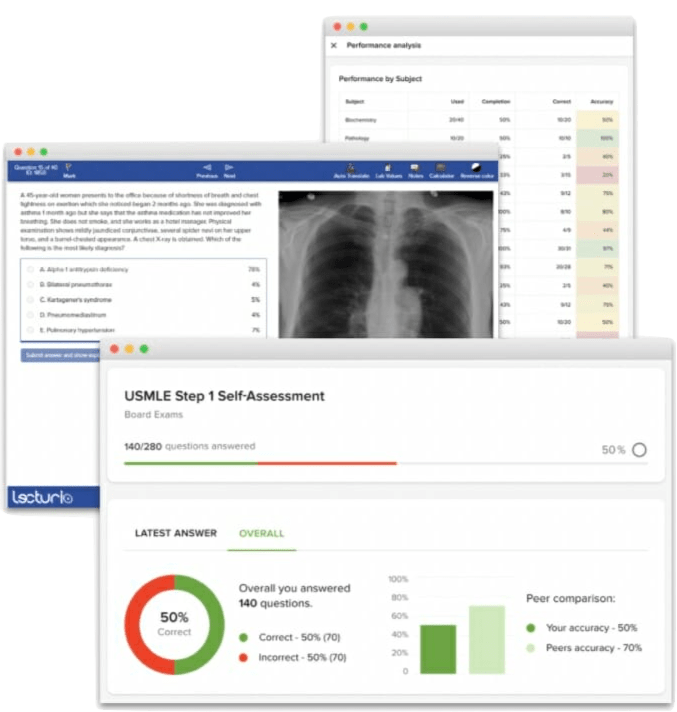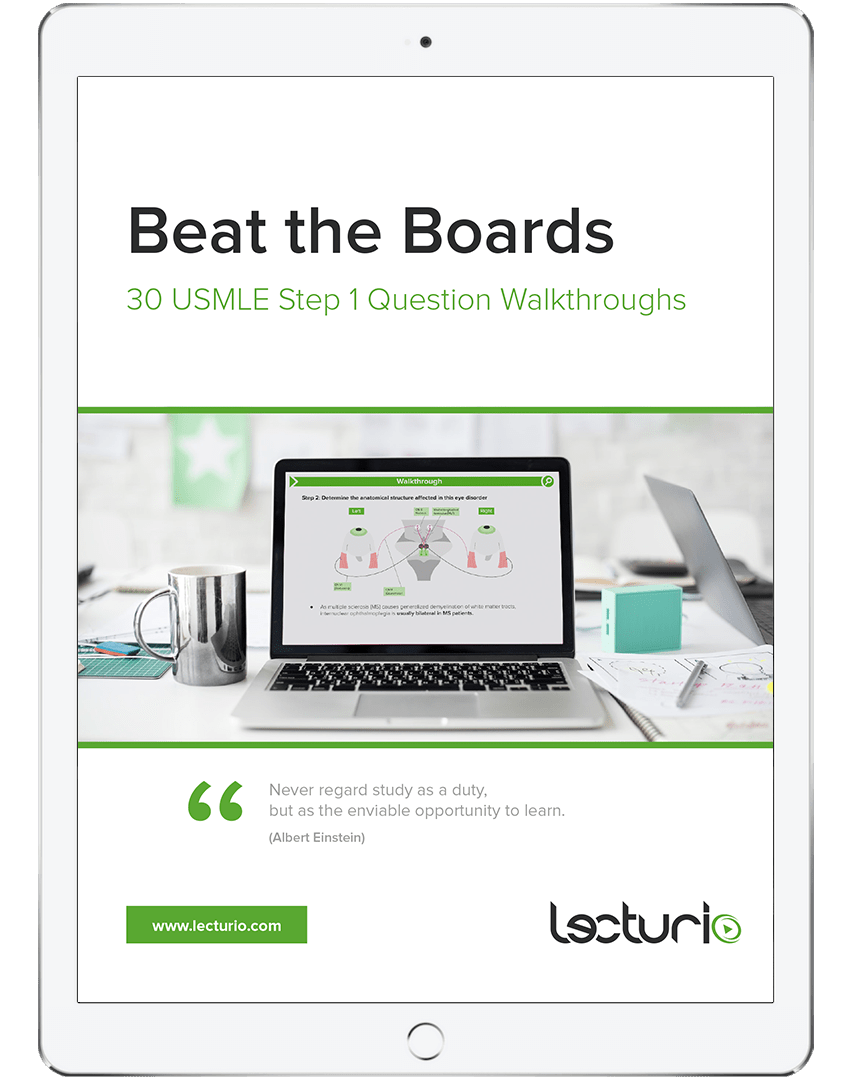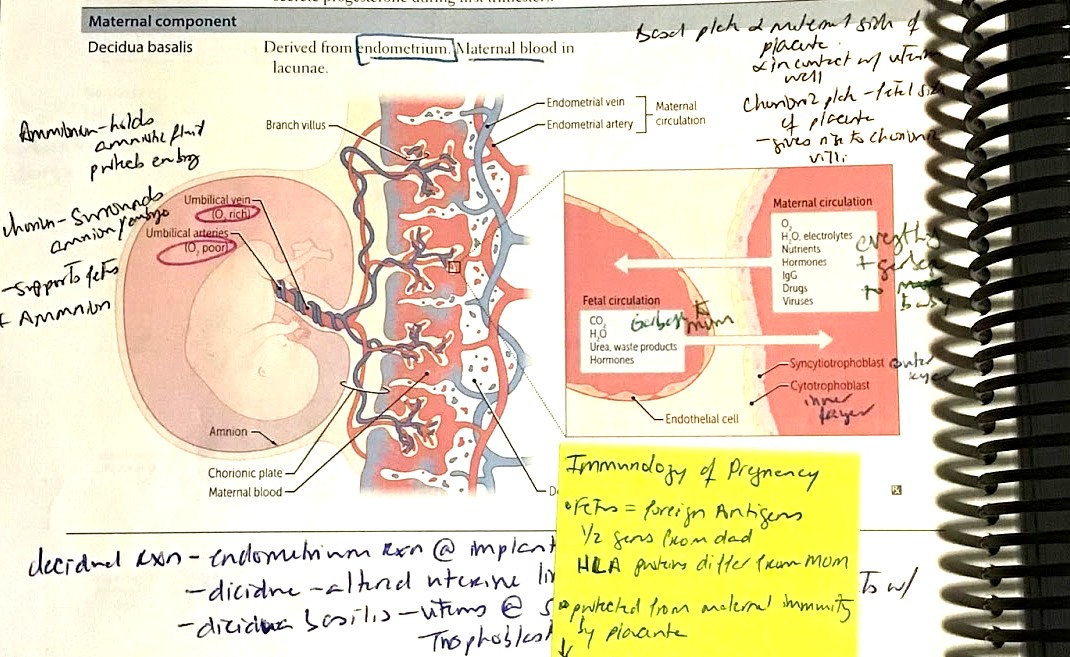Studying for Step 1 may seem like a daunting task at first – but by studying strategically and getting the most out of the resources you have, you’re sure to go into the exam well prepared. Use the following tips to find your best way to prepare for Step 1, or apply them to any other exams you have coming up!
How to Prepare for USMLE Step 1
Almost any medical student can pass the USMLE Step 1 exam. Because the USMLE is no longer numerically scored, it’s all about how strategically you plan and how carefully you study. Many students spend 3 months studying solely for the USMLE. However, life and circumstances don’t always give you the luxury of a dedicated 3-month period to study. Alternatively, students may find themselves in situations where they only have a month for intense USMLE study and some find themselves preparing in tandem with other responsibilities.
When life gives you lemons, make lemonade!
The best use of your limited time will be to focus on learning high-yield medical concepts and practice taking USMLE-style tests. The most effective tool for doing both of these is a question bank of high-quality, USMLE-style questions. Fortunately Lecturio has a few tried and true tips to share! Read on to maximize your time and resources as you prepare for Step 1.
With Lecturio’s learning science-based platform, you will spend much of your dedicated study period using practice questions in a question bank (better known as a Qbank) to learn high-yield medical concepts and test-taking strategies. Each Qbank question is designed to expand your knowledge base and familiarize you with the best way to work through other similar questions. Following this approach to your Step 1 prep will help ensure that you’re ready when test day comes.
Develop a study plan that allows you to simulate test-like situations
Whether you’ve structured your studies with Qbank-based learning or another method, you need to make sure you prepare for the exam itself. Just knowing all the content isn’t enough – being able to apply it to a clinical scenario is the key to success on exam day. The USMLE Step 1 exam is made up of seven blocks of about 40 questions, with one hour per block allotted to answer them. Training yourself to work through a 40-question block without interruption or distraction is perhaps the best strategy to make sure you’re ready for exam day. Emulating the setup of the USMLE during your studies makes sitting for 40-question blocks feel like second nature.
Get familiar with test-taking strategies
The physical and mental environment in which a question is delivered is just as important as its content. Lecturio’s unique Qbank Walkthrough Tutorials course & eBook will take you through 30 USMLE questions step-by-step, teaching you how to correctly read a question stem and isolate the key components of each. They will also guide you through the multi-step reasoning required for each question before reviewing that question’s specific high-yield information. The Lecturio Qbank is based on the latest NBME® standards and simulates your test day experience with the same look and feel as the Step 1 exam. Using a Qbank as your base allows you to learn from the test, rather than just learning for the test.
Test and apply your knowledge with the Lecturio Qbank
The USMLE tests clinical scenarios, so it only makes sense to practice clinical case questions for preparation. We recommend using Lecturio’s 40-Day Study Schedule, which comes pre-configured in our “Exam Resources” section.
If you’re just studying on your own, want to get a taste for what it’s like to sit through a block of the USMLE Step 1 exam, or want to mix up all topics rather than answer topic-specific questions, specify 40 questions per block as follows:
- Select “tutor mode off” and turn “timed mode” on (you want to get your brain used to the pressure of the clock – if there’s time pressure on exam day, you’ll be ready for it)
- Select the subjects/systems you want to review
- Select 40 questions
- Answer all 40 questions within a 60-minute timeframe
Review content covered in your question blocks
Once you finish the block, take a short break, then spend the next few hours reviewing what you just learned. Carefully read the answer explanations to the questions that you answered and consult your reference book and/or Lecturio videos to refine your knowledge. To start review mode in your Qbank test, select “review test” immediately after receiving your test results.
Using evidence-based learning strategies is easy with Lecturio – in fact, you’re already using some of these strategies! Interleaving, or learning by alternating the materials being studied, is easy with the following tips:
#1 Review content with the help of Lecturio’s detailed answer explanations
After each question, always opt to review and carefully read the explanations provided. Make sure to read both correct and incorrect answer explanations; there is just as much value in understanding why an answer is wrong as there is in understanding the right answers.
#2 Review with the help of Lecturio’s related videos
Supplement your understanding of the material by consulting Lecturio’s related videos. Each video reference has been hand-picked by board exam experts and explains the relevant concept needed to answer each specific Qbank question.
#3 Take notes and review with the help of First Aid® references
Before answering questions, review the topics in First Aid®. When first studying with your copy of First Aid for the USMLE Step 1, knowing how to use the book in the most efficient manner may not be obvious. The First Aid book is not written like a traditional textbook. Instead, it is full of bullet points, charts, and pictures. The most efficient way to implement First Aid is to use it as a reference and add your own notes as you go. When you watch Lecturio videos or complete Qbank questions and want to jot down some notes, do it in First Aid. That way, when you return to review content later, you’ll have one go-to resource for all your study information.
Related videos
We’re confident that using the tips above will put you on the path to USMLE exam success. With the right knowledge and preparation (and maybe a little help from Lecturio), you’re well on your way already. The rest is up to you. Now go out and pass that test!
How Long Should You Study for the USMLE Step 1?
How Do I Set Up a Study Schedule?
You don’t have to be great to start, but you have to start to be great. (Zig Ziglar)
Traditionally, students spend roughly three months studying in a dedicated fashion for Step 1.
But, you can get ready to ace your exam in 60 days by studying in the most strategic way possible and make the most out of each day.
In 60 days, there’s little time to be able to watch various lecture videos explaining all the basic science concepts a second time around, let alone taking down meticulous notes on every topic. Instead, the best use of your limited time will be to focus on learning high-yield medical concepts and practice taking USMLE®-style tests.
Lecturio’s 60-day Step 1 study schedule guides you through all the relevant topics with a day-by-day plan of a combination of high-yield videos and study materials, quizzes, and matching Qbank questions.
Quick FAQs & Further USMLE Resources
What is the USMLE®?
The United States Medical Licensure Exam is a three-part examination necessary to achieve licensure to practice medicine in the United States. Each “step” of the exam is administered separately, and the parts are referred to as Step 1, 2, and 3, respectively. Regardless of whether or not you are licensed to practice medicine in another country, passing the USMLE or an equivalent exam is necessary to practice independently in the US.
When to register for USMLE Step 1: application and eligibility period
In order to sit for the USMLE exam, you must submit an application and register for a three-month eligibility period. If you attended medical school outside the US or Canada, you must register through the Educational Commission for Foreign Medical Graduates; medical students in the US or Canada register for the exam at the National Board of Medical Examiners website.
Typically, medical students in the US and Canada sit for the exam after completion of their preclinical training in the first and second year of medical school. When you register, you will be prompted to select a three-month “eligibility period” when you intend to sit for the exam. You will then need to schedule a specific date for the exam within that three-month period through the NBME’s testing partner, Prometric. You can do this up to six months in advance of your proposed test date.
When to take the USMLE Step 1
Unlike other exams you may have taken in the past, the USMLE Step 1 exam does not have a standardized test date. You are free to schedule a test date that is convenient for you up to six months in advance through Prometric, the NBME’s testing partner. You can schedule your exam or reschedule it (for an additional fee) at any time through the Prometric website. The only restriction is that the exam must be scheduled during the three-month eligibility period that you selected during the registration process.
Many medical students in the US and Canada have a dedicated “study period” built into their preclinical studies specifically intended to help them prepare for Step 1.
This period can range from a few weeks to several months during the first or second year of medical school. Some schools however, do not offer any dedicated time for a study period for Step 1. Check your school calendar to see what the best eligibility period is for you for your exam, and when you should register for the test to maximize your chances of getting the test date you want.
Although you are allowed to schedule and reschedule your test at any time, it’s recommended that you schedule it as soon as you know your desired test date.
The availability of testing centers can vary widely from city to city. Prometric centers in larger cities or in locations that have a high concentration of medical schools may run out of appointments quickly, especially if many students are trying to take the exam at the same time. As a result, many students choose to take their exam at an alternative location, such as in their hometown or in centers outside of a major city where appointment slots are more available. Keep in mind that Prometric administers a variety of tests, not just the Step 1 exam, so availability may be affected by other test-takers as well.
How much does it cost to take USMLE Step 1? Are there Step 1 scholarships?
The current application fee for the USMLE Step 1 exam is $645. You can also extend your eligibility period, if needed, for an additional $70 fee. The application fee is nonrefundable, even if you are unable to take the exam during your eligibility period. Unfortunately, the USMLE does not offer any type of fee assistance for the application fee or waivers.
There are a handful of private scholarships available for the purposes of taking the USMLE exam. If you are in need of financial assistance, discussing your situation with your medical school’s financial aid office is often the best strategy to determine your eligibility.
How is Step 1 graded? Is Step 1 a pass/fail exam?
Starting January 26, 2022, exam results for USMLE Step 1 transitioned from a numerical result to a pass-fail system. If you took the test before that date, your results were reported as both a numerical result and a pass or fail; going forward, all exam results will only be reported on a pass-fail basis.






